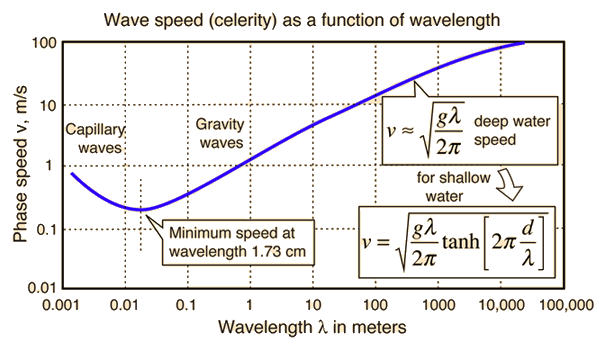If we're thinking about reference frame of Aether, we can put the following question: if the particle of environment, forming the wave cannot be observed by such wave by definition, maybe the neighboring particles can still remain observable?
But from transversal character of prevailing energy spreading follows, the detection of environment is problematic even at the case, we will consider non-local effects/phenomena. The real life experience with surface waves can explain it again. The real water ripples are surprisingly complex mixture of transversal and longitudinal waves, depending the water depth and wavelength in particular (
gravity waves,
Rayleigh-Lamb, (Q-, P-, S-)
Love and
capillary waves).
The driving phenomena is dispersion here. The waves of very long wavelength are gravity waves, they're of longitudinal character and the compressibility of water takes place here. The speed of motion of such waves (celerity) is completely additive to speed of water environment itself, being driven by Galileo transform.
The very tiny waves of wavelength bellow 1 cm are so small, they're dispersed by density fluctuations of water molecules (the analogy of Rayleigh dispersion of blue daylight by density fluctuations of atmosphere). The celerity of such wave is additive to speed of environment, too.

But in certain intermediate range (about 1.7 cm or so) the speed of surface waves passes minimum, because in this range the effects of both short distance, both long distance range dispersion
can be minimized. Such waves are called the
capillary waves and they're of pronouncedly transversal and as such non-dispersive character. With respect of such waves the water surface is behaving like thin elastic membrane hanging in the free space with (nearly) no underwater dispersion at all. Because of lack of dispersion, these waves of minimal speed 23 cm/s (1/2 mph), so they can spread the energy/information with the maximal intensity and the speed of energy spreading doesn't depend on the speed of water environment - which is the behavior typical for light spreading in vacuum, as described by relativity theory.
Such behavior is the more pronounced, the more pronounced is the surface gradient. Because the vacuum is of extremely high density, these waves are the nearly exclusive source of information here with very subtle reference frame (
Lense-Thirring effect). This doesn't mean, the energy cannot spread in longitudinal waves through vacuum - it indeed can. But we aren't observing such waves in the intermediate scale of wavelength because of their weakness and quantum noise, which is the result of dispersion and separation of time arrows.
The interesting coincidence is, the 1,7 cm wavelength corresponds those of cosmic microwave background nearly exactly - it can be considered as the middle of dimensional scale of our Universe, because it allows the energy spreading from the oldest and most distant parts of Universe - from the Big Bang event directly. It's not accidental coincidence, the 1,7 cm wavelength corresponds the scale of human neurons - its the scale of maximal Universe complexity (neg-entropy) achievable because of lowest speed of information spreading.




